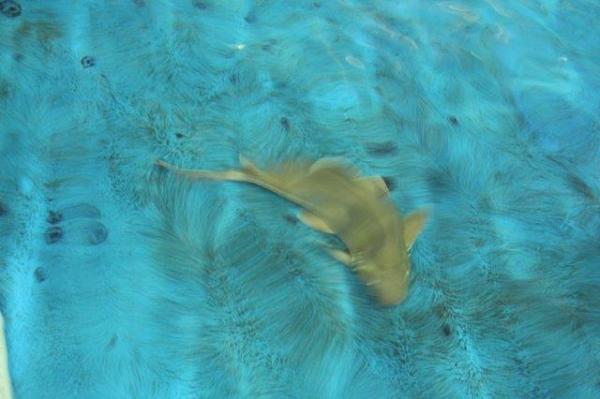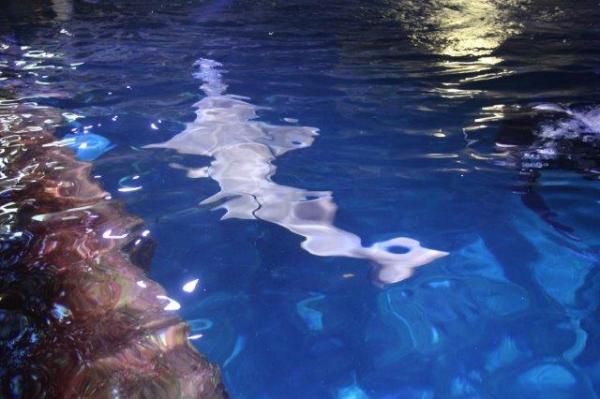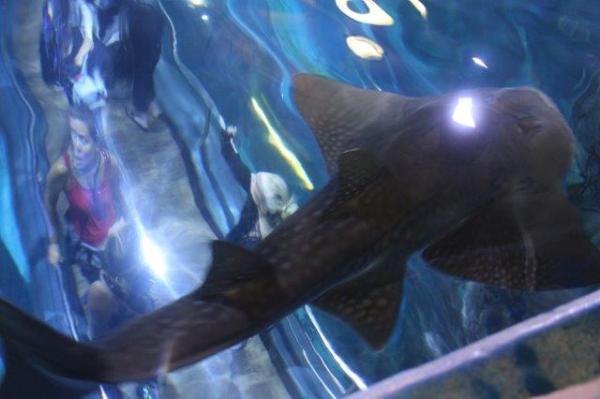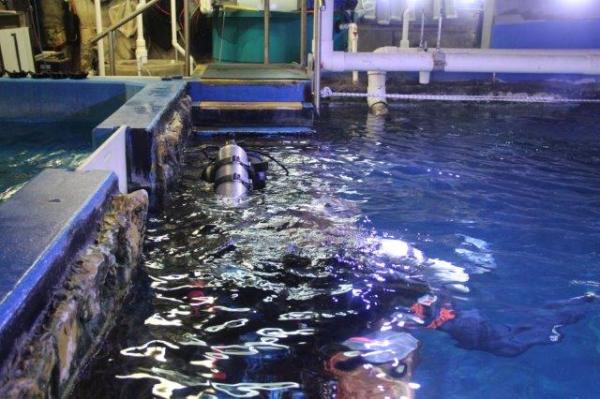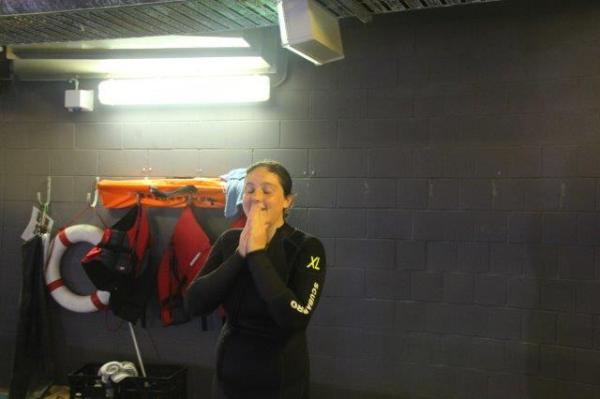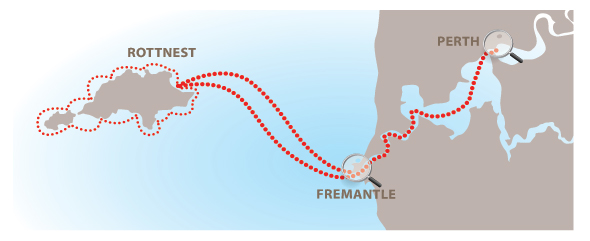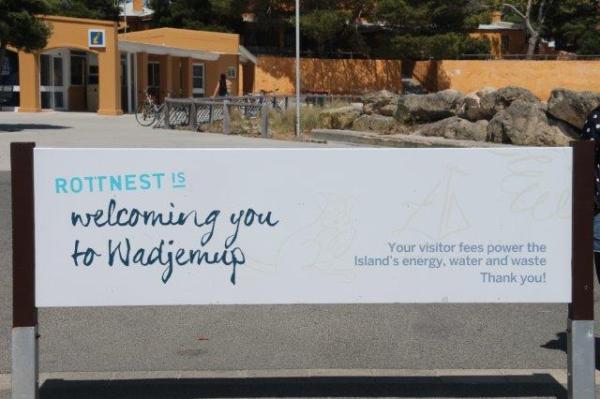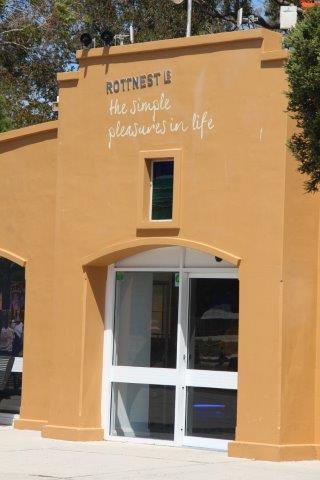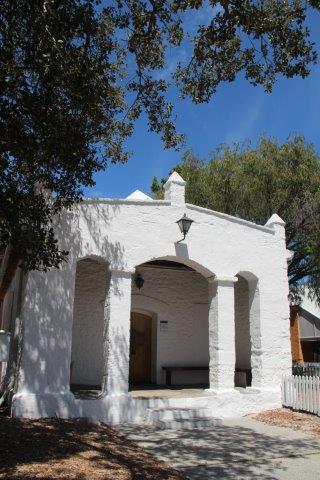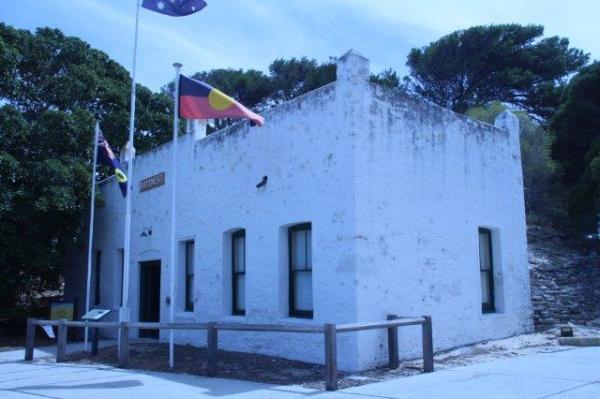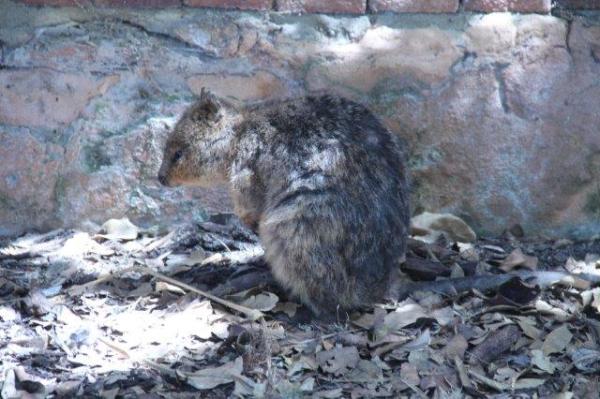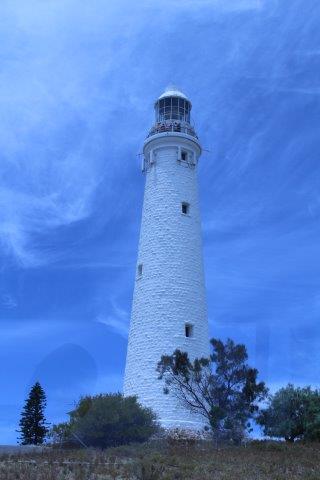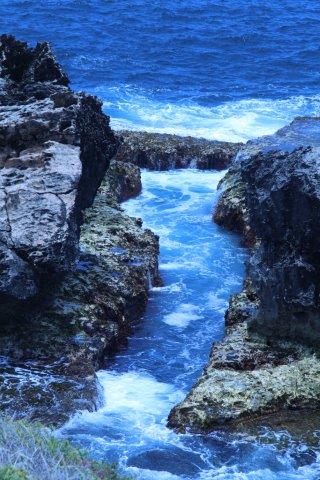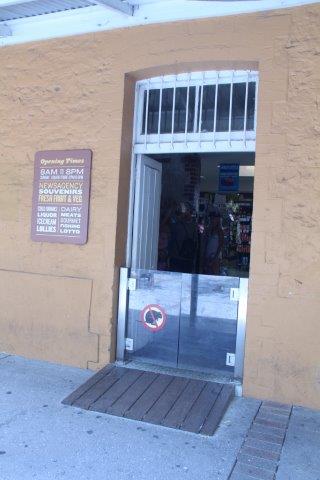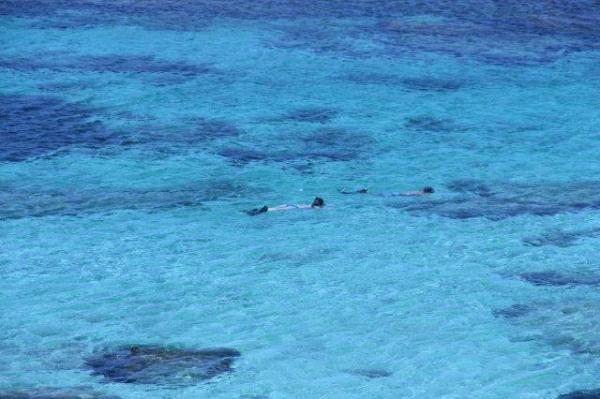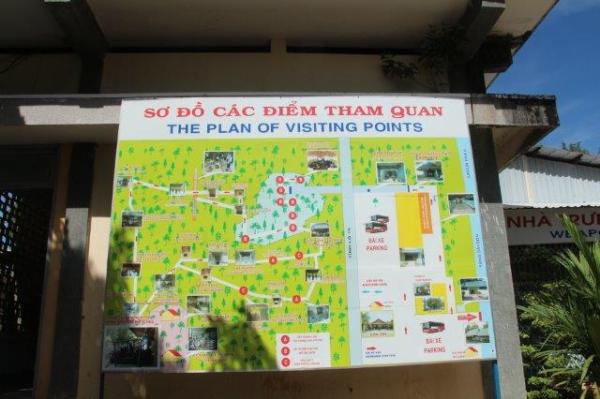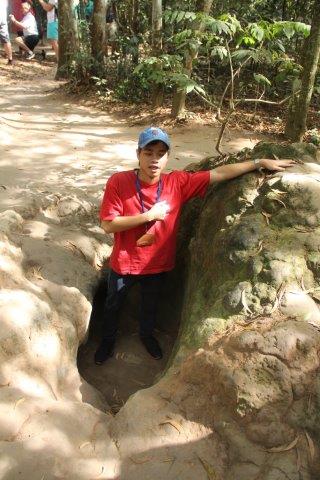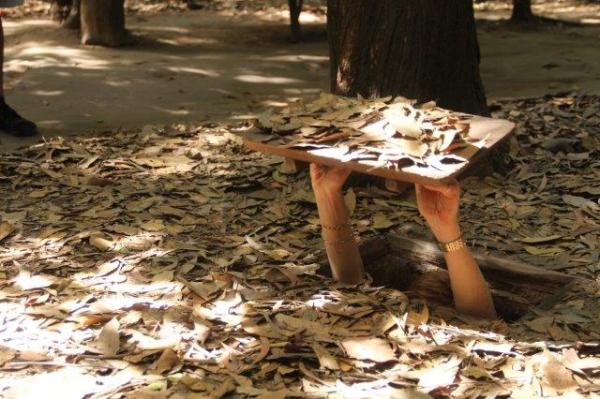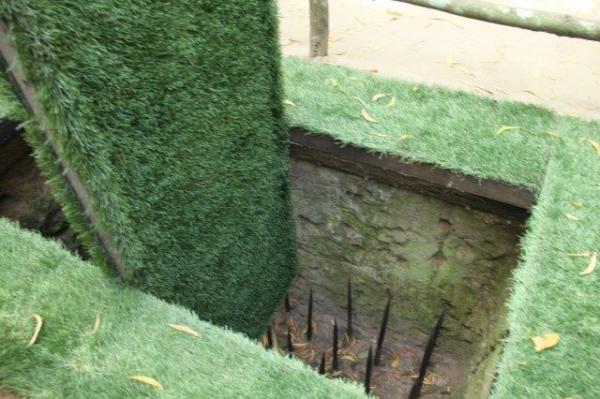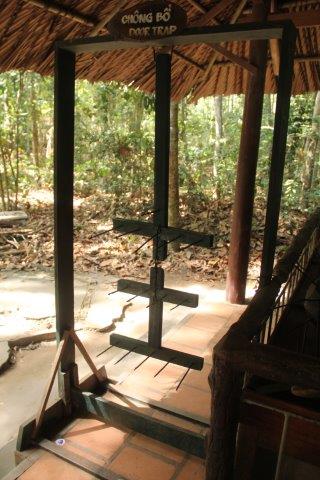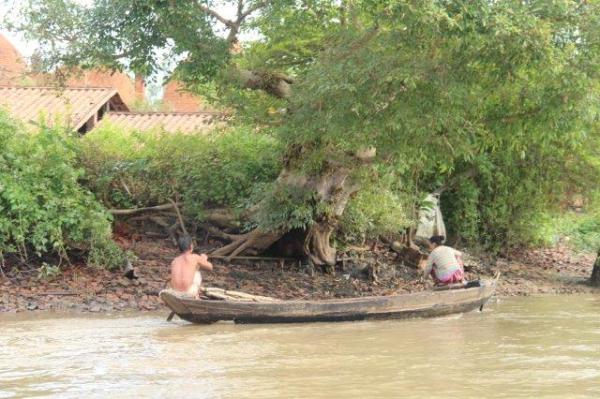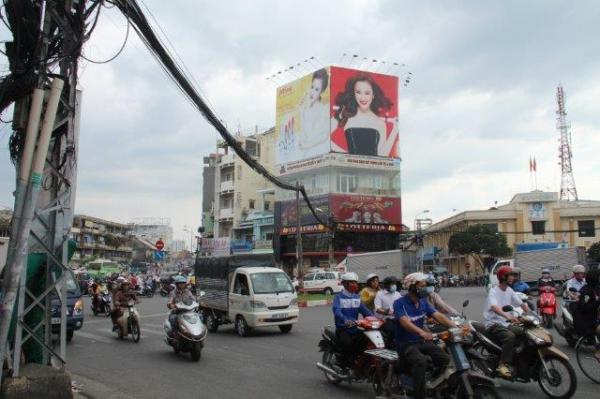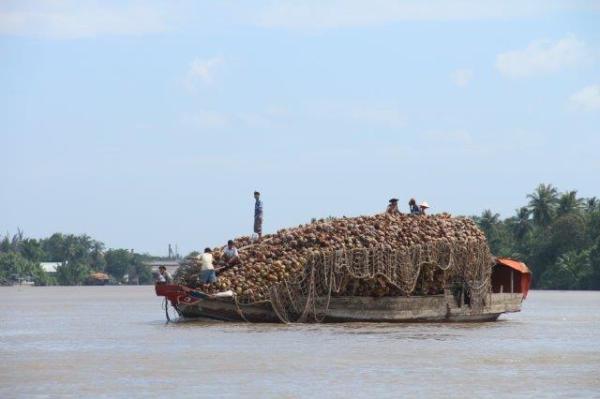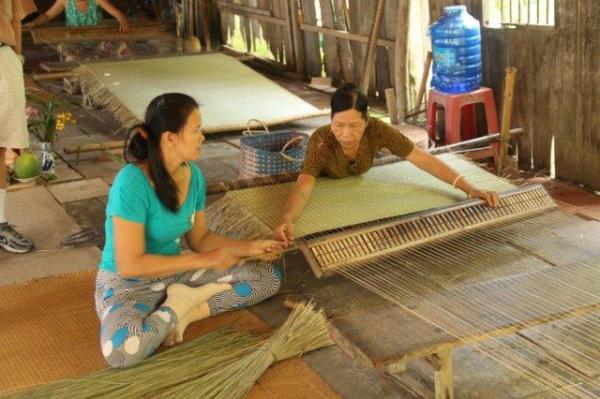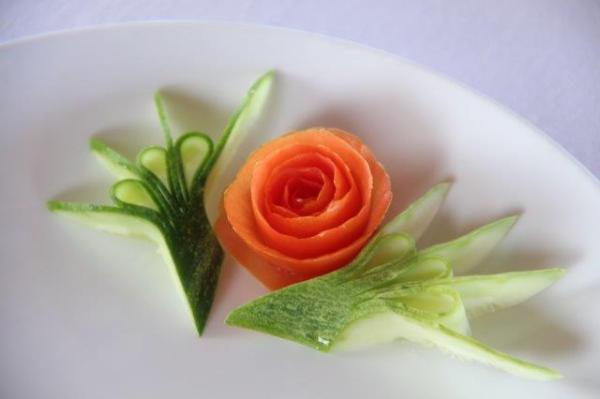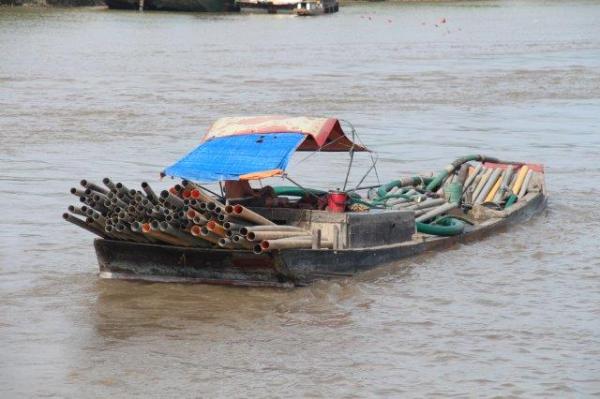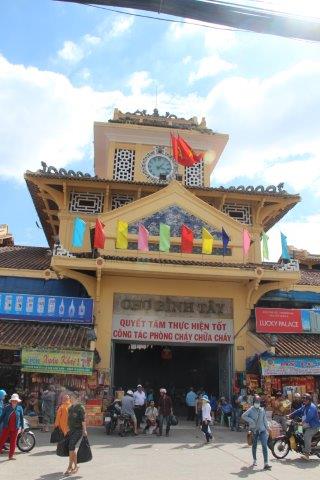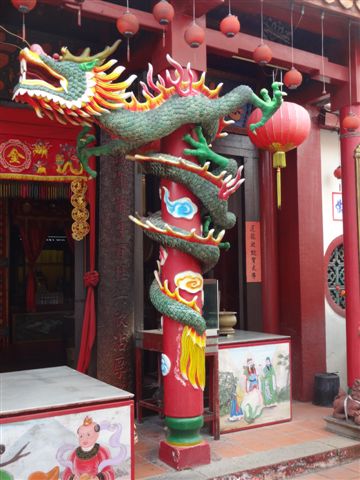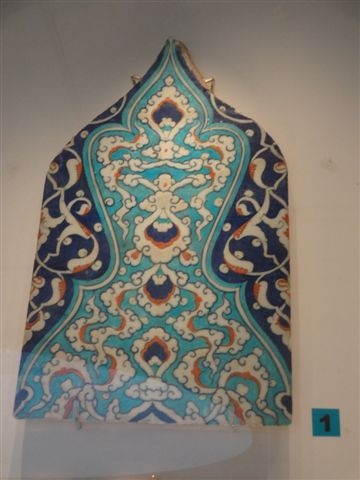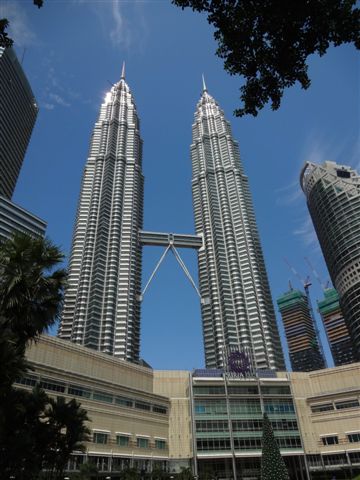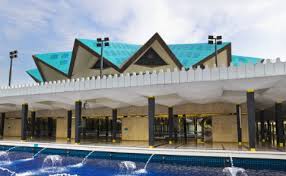The Colorado River is life. For millions of years its 2,000 km flow from the Rocky Mountains to the Gulf of Mexico has refreshed and powered seven US states. The cool fresh water quenches 25 million people and irrigates 3.5 million acres of farmland. On the Colorado Plateau, the relentless flow has slowly worn away the hard granite rock to carve a channel deep in the Earth’s crust. The river leaves in its wake one of the most stunning Natural Wonders of the World … the Grand Canyon.
Today I am to visit the Grand Canyon, but I feel unsure … what will I see? How will I feel?
I’ve made a classic mistake of course – thinking “it’s not far from Las Vegas … so it won’t take long to get there, right?”
Well … wrong …
At its closest point (the West Rim) the Grand Canyon is 200 km from Las Vegas. But that’s not even where I’m headed. Today I am to visit the South Rim … and that’s a whole other prospect … I learn it’s 450 km away.
One good thing about my journey to the South Rim is that at least there are interesting things along the way. I pass Hoover Dam and Boulder City then get to Kingman. From here, I take a section of Route 66 to Williams – the last town to be bypassed when Route 66 was superseded by Highway 40 in 1984. Now, although it hosts the terminus of the Grand Canyon Railway for visitors to Grand Canyon Village, Williams relies heavily on its Route 66 history and cult following for tourism. Its main street boasts a range of fifties and sixties style stores with memorabilia and some ‘wild west’ history too.
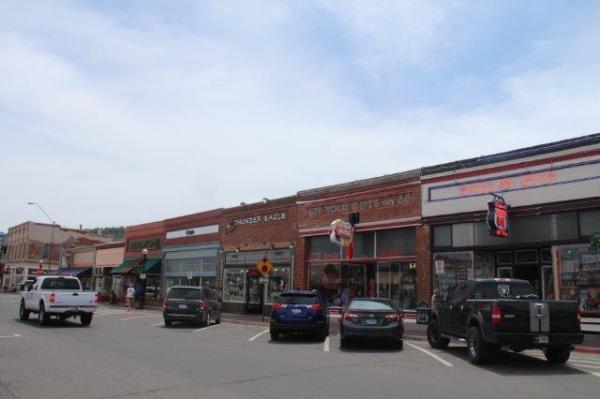
Route 66 – runs through Williams’ as the Main Street
I find a very nice sandwich here at Cafe 326, then head north from Williams and expect the mighty Grand Canyon to appear before me at any minute … at every bend in the road I brace, ready to see its vastness. That’s another misnomer – although it’s 16 km wide and could hold 4 million Empire State Buildings, the Grand Canyon is deep – not high – so it can’t actually be seen from a distance. This is a difficult one for my brain to comprehend.
Wait … what? …. a 6,500 square km crevice carved into the Earth – could actually be passed by without me knowing it? …..
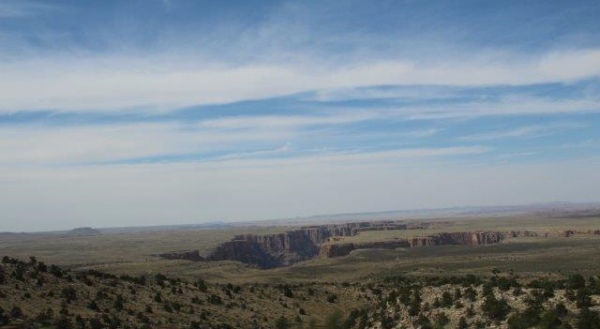
The giant crevice in the Earth’s crust – seen from about 20km away
The road goes on …. and on … and on …
Come on! …. am I even going to get there today?
At last I arrive at Grand Canyon Village … I’m here!!
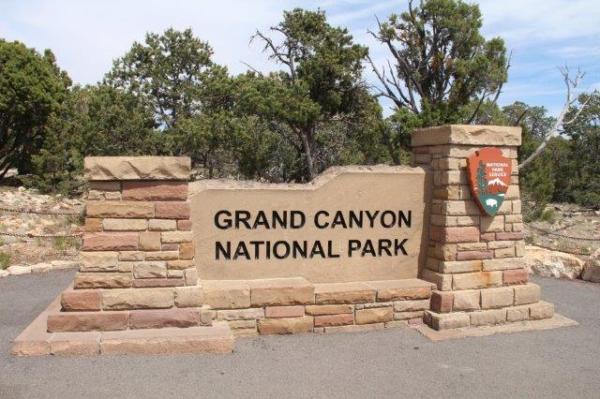
I’m here!
I drive into the South Rim car park. I see trails, but I don’t yet see any Canyon … where is it? which way?
From the car park I follow signs along a short walking track. There’s a few people around, but it’s not noisy … I can feel, I can hear … I know it’s coming. The trail snakes around a bend … then I see something … ahead I can make out distinctive red layers and haze … the trail broadens out to a platform … yes … I’m here.
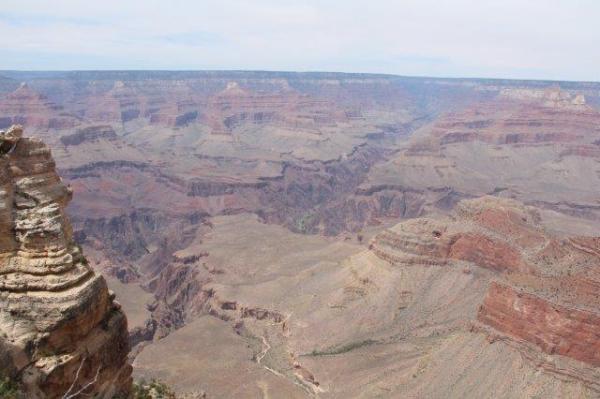
Grand Canyon – view from the South Rim
I take a few tentative steps forward and wait for the feeling to hit me … my eyes can see it – but … my senses are numb.
What am I looking at?
What is this in front of me?
How do I make sense of what I see?
I’m standing at the rim of the Grand Canyon. A fence stops me going further forward … I grasp the handrail and I just look. The sight and sheer size greets me – but I stop – I don’t know what I’m seeing … I feel nothing.
The people around me dissolve into my sub-conscious … I stand quietly and let the view soak through my brain. I can’t process it.
I stop and let it happen …
I slowly start to move – I step back from the view and go left a few metres along the trail … I stop again, I look, I take it in …. then I walk back the other way …
My guide is correct … it doesn’t matter where you find your vantage point, it’s so big everyone gets their own place to experience it.
This is mine … I stand and let it happen.
I can’t see down as far as the river, but I can see the deepness of the gorge – it’s almost 2 km down to the water.
My brother’s words come to me ….
“It’s not the fall that hurts – it’s the sudden stop at the bottom …”
The height and the drop don’t frighten me – in fact, I feel a sense of peace and calmness.
My senses start to awaken … now I feel it … my eyes start to appreciate the beauty.
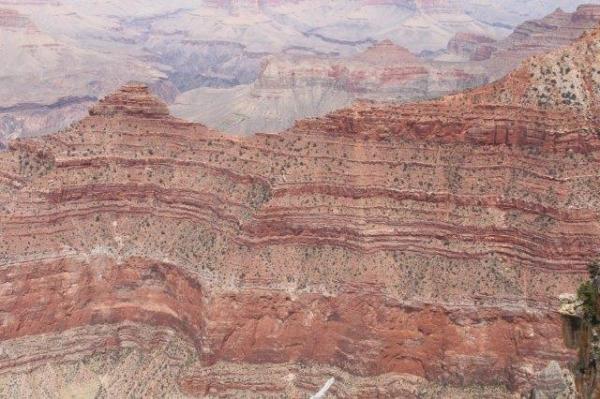
The russet layers
The russet colour of the rock is the first to strike me – the even layers snake their way around the cliffs, each giving a natural “tide mark” to the canyon walls and a pointer to the passage of time. The colourful strata were set down during the creation of the plateau, then exposed again as the river gradually eroded its way through the granite on its journey to Mexico.
From where I stand, it’s ten … yes, TEN… miles across to the other side. It’s these numbers that give me so much trouble in appreciating what I see. Apart from the people – all on the side I am on – there’s no point of reference. There’s certainly nothing possible to compare and gain a perspective. My eyes pore over the surface of the rocks – the colours and patterns are only something nature could make. Thousands of hues of rusty red, beige and black. A painter would enjoy emulating these colours in their work … the variations tease my eyes and make my heart sing … I am confident that the overused word “awesome” is right to use here.
After a while, I drive around to the Desert View observation point. Here, at least I can see down to the Colorado River.
Aah, that’s better – now I can at least get a better sense of it.
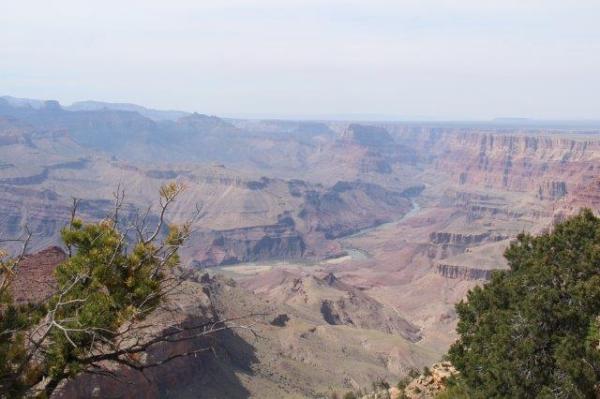
Grand Canyon, Desert View
From here, the green Colorado River clearly works its way left to right, towards the Gulf of Mexico. Yes, now I can get it straight. The wind blusters around me, it’s precarious … there is no guard rail here, so a visitor could just keep on walking if they wanted to (or even did it by mistake). It seems people don’t come here to do that though – 48 million people visit the Grand Canyon each year, but records show that as few as 12 people are lost through falls into the Canyon annually.
Well at least people keep their wits about them when they’re here, particularly on a blustery day like today.
This region is a sacred site for indigenous Native Americans, whose people have lived in natural caves and built settlements along the canyon floor since 1200 BC. Those who live a little further away take pilgrimages to visit this holy ground. The first people to live in the Grand Canyon were the Ancestral Puebloans, (also referred to as the Anasazi – Navajo for “Ancient Ones” or “Ancient Enemy”). Over the centuries, other cultures have inhabited the area – primarily Cohonina, the ancestors of the present day Yuman, Havasupai, Hualapai and Walapai people; Europeans arrived here in the 16th century.
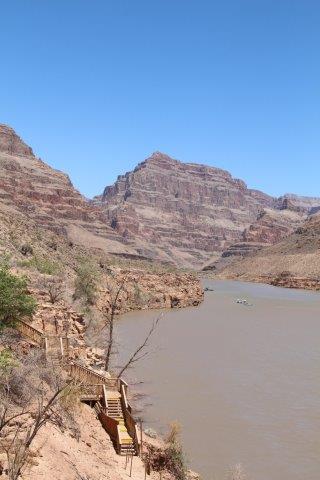
Jetty at Haluapai River Riders
The Hualapai people are still in the area and they live within their own “reservation” – land that’s been identified by the US Government for habitation by the Native Americans. It is partitioned off from the rest of the National Park. Within the “reservation”, Native Americans run their own businesses and live under their own laws, outside the jurisdiction of the US Government. The traditional Haluapai land is at the West Rim – which I reach by helicopter.
My pilot, Chuck, drops me off on the banks of the river. My first experience here is to take a river cruise along the mighty Colorado, so I make my way to the jetty. The Hualapai people provide a cruise for visitors along their portion of the river. These are the Hualapai River Runners – at first there’s a bracing ride at speed for 2km along the river, then it becomes a relaxing and spectacular return trip as we cruise back to the jetty – the sun blazes down, the river glides and the 4,000 ft granite peaks tower high above me.
After the cruise, I take a helicopter back up to the “rim” – to Grand Canyon West Airport. Here a shuttle bus transports visitors around the Hualapai Reservation which offers three places of interest. The bus runs often and it’s possible to spend good time at each stop. First stop – Hualapai Ranch. The mood of this area is relaxed and fun, but informative. It’s operated by Native American staff who help visitors understand their culture, traditions and practices. A particular favourite amongst visitors is the “quick-draw” competition where two wanna-be cowboys see who’s fastest on the pistol draw. People get a sense of the “cowboy” heritage of this area … and non-PC visitors may recall their own childhood “Cowboys and Indians” pursuit games with some fondness.
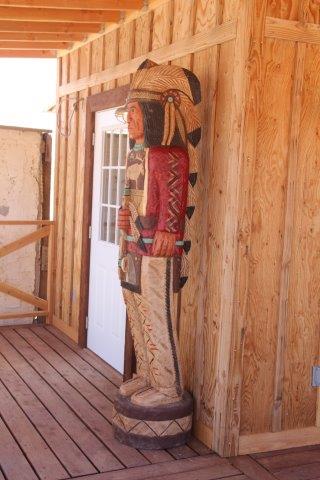
A guardian stands outside a Haluapai Ranch store
I enjoy the crafts on display here – colourful pottery and lovely turquoise and silver jewellery. Native Americans recognised the wealth of the minerals in Nevada centuries ago. They used the copper and silver for arrowheads, spear points and tools.
This was the beginning of Nevada’s rich mining industry – particularly in silver, which was a key contributor to the state’s economy and lead to Nevada being admitted to the United States in 1864. Of course, tourism and gaming dominate the economy today, but Nevada is still a significant national and international source of metals and minerals such as gold, copper, molybdenum (for steel), lithium, gypsum and lime.
This is what can cause the waters in the Colorado River to colour so brightly – depending on the day’s runoff from surrounding rocks – copper makes green water; iron makes red “rusty” water.
Next stop at Grand Canyon West Rim is Eagle Point – a popular stop for most of the visitors to Grand Canyon West. Here, the courageous can take their turn on the SkyWalk – a horseshoe-shaped bridge that features a glass walkway. Walkers can see down to the river, 1,450 metres (4,000 feet) below, as they walk.
Yes … it’s not for everyone.
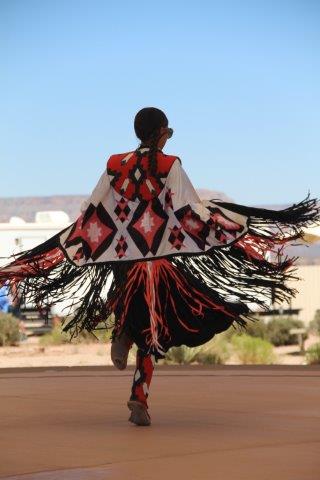
Spectacular traditional dance
My favourite feature at Eagle Point is the experience of Native American culture at the village. I enjoy the traditional dance and music. The costumes are brightly decorated, made of suede and leather with tassles, feathers and braids. As the dancers move the adornments fly out to create a colourful, moving space around them. The music is dominated by chanting and a regular tom-tom beat …
Heeeee … un, un, un
Heeeee …. un, un, un ….
it’s mesmerizing. They don’t invite me to join in … shame.
The tribal heritage is demonstrated through several types of village structures – they’re adobe, mud that’s been baked in the hot sun … so hot that eggs will cook in an outdoor pan without fire. The ingenuity of the huts intrigues me – the natural material keeps out the heat, but they’re constructed in a cone shape where an opening near the top facilitates movement of steam that’s important for prayer rituals – during prayer, steam is believed to cleanse the mind, body and spirit.
It’s fascinating – the tribes make the most of all their natural resources and the botanical ingredients of their surroundings. One particularly catches my eye … the Hogan.
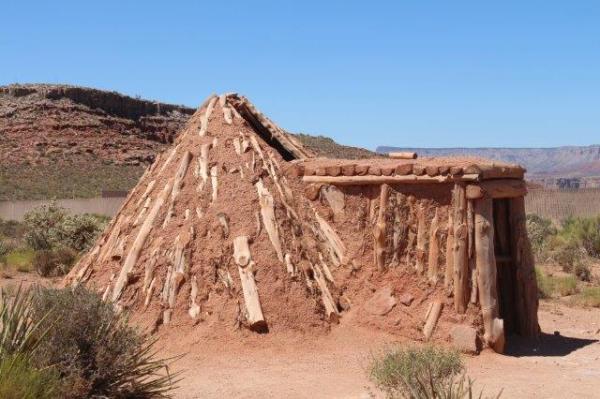
Intriguing Hogan ….
A Hogan is traditionally built using wood and mud. The mud is important because it is a part of the Earth and the wood pieces are carefully selected – they can’t come from any tree struck by lightning, as objects struck by such a powerful force are said to have lost their spirit. The structure’s wooden beams create a funnel for light and the circular shape at the base symbolises the World. The entrance faces the East because everything that is good and prosperous comes with the dawn of a new day and an eastward facing entrance invites blessings into the home.
How wonderful … it’s so simple – yet everything has a deep spiritual positive meaning …
Most spectacular of all at West Rim is the final stop – Guano Point. Here, the red strata on the sheer canyon walls draws me closer to the view. The area is shaped like a pyramid and a walk to the tip rewards me with an almost 360-degree perspective of the Canyon – breathtaking.
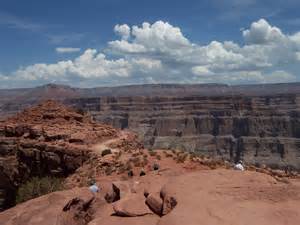
Guano Point
In the early 20th century an aerial tramway crossed the Canyon here, to reach a cave filled with valuable guano (bat droppings) – high in phosphate and a critical ingredient for fertilizer. In 1957, the U.S. Guano Corporation estimated the cave held 100,000 tons of guano with a net worth of $12 to $15 million USD. But, of course, the cave was in a hard-to-reach spot. The first attempt at mining the guano involved building a tramway to connect the cave with a barge dock below.
But … although it was a good (albeit ambitious) plan, the risks gradually overtook the rewards – the company went bankrupt as a result of high expense for motor repairs and barges that were sunk during the operation. The tramway tracks still cross 3 km to the other side of the canyon – it’s impressive. Such engineering prowess back in the early days!
Actually … even today, that would be something to achieve.
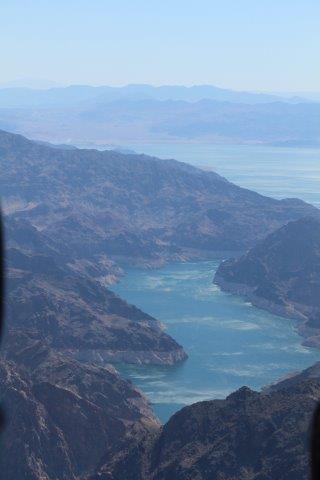
Lake Mead, from my helicopter
I make my way back to Chuck at the helicopter. We take off and fly back to Las Vegas, over spectacular Lake Mead – a lake created during the flooding of the Colorado River for the Hoover Dam.
Once the two year construction of the dam was completed, the wonderful lake took seven years to fill. In water capacity, it’s the largest reservoir in the US, with over 1,200 km of shoreline. It provides water to Arizona, Nevada and California.
It’s also a beautiful water feature and popular area for leisure and water pursuits for visitors and locals.
Its blue waters and unique shoreline provide a spectacular backdrop to the flight back to Las Vegas. Although it provides water for over 20 million people and acres of farmland, the Lake suffers from factors that have diminished its reserves – natural drought and increased demand. It has recently seen a drop in its levels. This is quite evident from the air, particularly where the banks only gently slope into the water – here the receding water line is bright and stark.
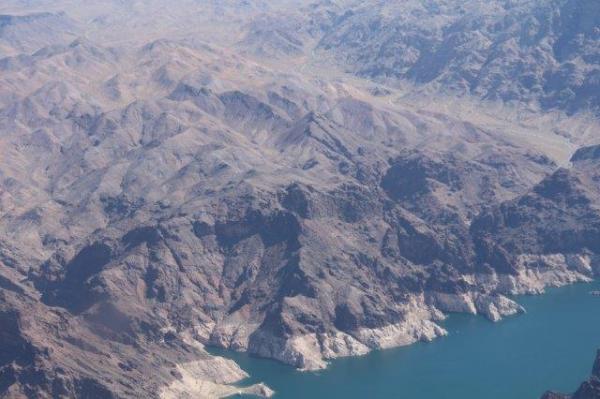
The lighter banks show the receding Lake Mead
It’s plain to see from this vantage point that the magnificent Lake is not what it once was. Boating is the most popular leisure activity on the Lake, with fishing, water skiing and swimming all attracting holidaymakers. It has four marinas and house-boats are dotted around its many coves that feature rocky cliffs and sandy beaches. Depending on the water level, several small islands can appear too.
Our flight continues over the Hoover Dam and back to McCarran International Airport in Las Vegas. This airport’s deceptive – because the famous Las Vegas Strip has such massive buildings, the airport – although a major international hub – is dwarfed into seeming more like a small city operation, which it is not … by a long way. 40 million visitors come to Las Vegas every year and most use this airport for their transfers into and out of the city.
All too soon, my 45 minute direct flight back to Las Vegas comes to an end. Chuck flies me over The Strip, to get a good view of the brightly lit human drawcards, giant replica’s of famous landmarks and remarkable hotel facades – all there to draw the excited crowds. Then we land at McCarran.
It’s over .. my visit to the Glorious Grand Canyon …. what a marvellous day.
Now … to survive Las Vegas itself – that’s a story for another day ….

